-

新人教版高中英语必修2Unit 2 Wildlife Protection-Discovering Useful Structure教案二
2.表示现阶段正在进行的被动动作(该动作在说话的瞬间未必正在进行)。Many interesting experiments are being carried out these days.(说话时,并不一定正在进行)3.表示一种经常性的被动行为,常和always,constantly 等表示频度的副词连用,这种用法常常带有赞扬或厌恶的感情色彩。He is always being praised by the leader.4.表示按计划或安排主语将要承受谓语动词所表示的动作(仅限于少数及物动词)。A party is being held tonight.Step 4 Special cases1.像take care of, look after, talk about, think of等动词与介词构成的短语用于现在进行时的被动语态时, 其中的介词不可省略。The ways to stop illegally hunting are being talked about. 2.可与部分情态动词连用,表示对正在发生的事情的推测。She may be being punished by her mother.3.有时可表示按计划或安排将要进行的一个被动动作。A celebration is being held this weekend for his success.4.某些表示“状态、心理活动、存在”等的动词,如have,want,need,love,一般不用现在进行时的被动语态,而常用一般现在时的被动语态。With the population increasing,more land is needed.5.“be+under/in+n.”可表示现在进行时的被动意义。My computer is under repair.=My computer is being repaired.

新人教版高中英语必修2Unit 2 Wildlife Protection-Discovering Useful Structure教案一
The activity topic of this section is "report an ongoing event", and the structure is the passive voice of present continuous tense. Rare wild animals are suffering from large-scale poaching, and species are on the brink of danger. Rescue operations are underway. "Being" and "suffering" are the meanings of the present progressive passive voice.The usage of present progressive passive voice is of great importance in writing a good discourse and appreciating some difficult language items, so it is vital to master it and use it flexibly in a context.1. Motivate Ss to deepen the understanding of the usage of present progressive passive voice in a fixed context.2. Enable Ss to master the usage of present progressive passive voice and use it flexibly in a context.3. Lead Ss to construct sentences or appreciate sentences used master it and use it flexibly in a context.1. Help students to appreciate the function of the usage of present progressive passive voice in a sentence2. Instruct students to write essays using the proper usage of present progressive passive voice.Look at the picture and tell me what are workers doing? What is the house being done?

新人教版高中英语必修2Unit 2 Wildlife Protection-Listening and Speaking教案
This lesson is about wildlife protection. The listening and speaking is about “How to protect endangered wildlife ?” Faced with the facts and numbers of wildlife loss, people begin to detect the reasons, then people such as the celebrities (Prince William and Yao Ming) are calling on to protect them. So students are guided to enhance the awareness of protecting wildlife and try to take part in some volunteer activities of protecting wildlife.1. Predict the content by using visuals. 2. Learn to use the sentences such as “I’m concerned about.... But now they are in danger. I want to know the reasons/why./ What can we do to protect them ?3. Learn from the stars like Prince William and Yao Ming and enhance the awareness of protecting wildlife.4. Guide students to try to put forward the solutions to the problems of wildlife protection and then discuss them with partners and present the results of discussion.5. Master the pronunciation of stressed syllables.1. Learn from the stars like Prince William and Yao Ming and enhance the awareness of protecting wildlife.2. Guide students to try to put forward the solutions to the problems of wildlife protection and then discuss them with partners and present the results of discussion.3. Learn to use the sentences such as “I’m concerned about.... But now they are in danger. I want to know the reasons/why./ What can we do to protect them ?4. Master the pronunciation of stressed syllables.Part A Listening and Speaking--- How to save endangered wildlifeStep 1 Lead in1. Point at the pictures on P14 and ask Q1: What message do these posters share?

新人教版高中英语必修2Unit 2 Wildlife Protection-Reading and Thinking教案二
The theme of this unit is human and nature, focusing on the theme of wildlife protection. Nature is a complex ecosystem, in which there are delicate balance between animals and plants. Because of the role of the food chain, the extinction of one species will produce influence, causing a series of chain reaction. Large scale extinction of species will have a serious and even irreversible impact on the ecosystem, resulting in immeasurable losses. Therefore, it is of great significance to protect wild species. To protect wild species is to protect human beings themselves. The motto of this unit is "when the buying stops, the killing can too,” which is a public service advertising slogan to protect wildlife. It tells people that every rhinoceros horn, every fur, every bowl of shark fin soup, every Ivory product, and every tiger bone product, etc. consumed by human beings, are innocent wild animals slaughtered behind them. The mission of wild aid is to ban illegal trade in endangered wildlife and mitigate climate change. It aims to educate the public to reduce the consumption demand for endangered wildlife products through public publicity and improve the awareness of environmental protection.1. Improve the awareness of wildlife protection by acquiring the knowledge of wildlife protection.2. Focus on environmental protection and protection of all lives.3. Analysis of the living environment of wild animals with appropriate thinking mode.4. Skillfully use the vocabulary and grammar knowledge of this unit to cultivate self-study ability according to the unit content5. Develop cooperative learning ability through discussion and other ways1. Enable the Ss to talk about the current situation of wild animals.2. Guide the Ss to summarize the main idea of each paragraph as well as the main idea of the text.
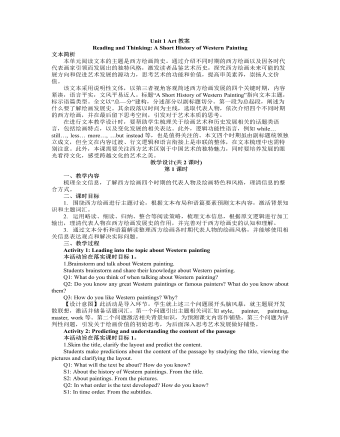
新人教版高中英语选修3Unit 1 Art教案
[2] An important breakthrough…was… [3] Another innovation was … [4] the emphasis increasingly shifted from…to… [5] New ideas and values gradually replaced… [6] While his paintings still had religious themes… … T: All these expressions serve to show how Western painting has developed. Some of them share similar structure but with varied use of words, which makes the text vivid and more readable. 【设计意图】主题类语言整理有助于学生类化语言应用,提高语言输出的丰富性。处理完文本内容信息后,进入语篇信息处理,进行主题相关的词块归类。引导学生快速阅读,寻找表达相同主题(发展或者艺术)的词和短语,再根据词性、用法和结构进行归类,储备主题相关词汇,丰富语言储备,提升语言素养。 Assignment: Go online to gather more information about Chinese painting and write a short history of it. 【设计意图】结合所学,迁移运用,根据实际语境,进行模仿性运用。在此过程中,学生尝试借鉴已学的语言、内容、语篇结构和写作手法来建构新文本,实现语篇输出,同时关注中西艺术文化的差别,加深对优秀文化的认同,培养文化意识。

新人教版高中英语选修4Unit 2 Iconic Attractions教案
帮助学生通过讨论与对主题的提升,反思自己的旅游方式,以便做出更优化的安排,在今后的旅程中有更多的收益。 Activity 2: Further discussion of the 6 elements above and supplement of more background knowledge 本活动为实现课时教学目标2。 1.Target Q: The writer’s clear target of traveling, meeting the people and experiencing the culture, is closely related to his major in social studies. Then what is social studies? Social studies is a part of a school or college curriculum concerned with the study of social relationships and the functioning of society and usually made up of courses in history, government, economics, civics, sociology, geography, and anthropology. (Dictionary by Merriam-Webster) Reflection: When you go out to travel, what targets do you usually have in mind? 2.Research Q: Suppose you are traveling to Hangzhou during the school holidays, how will you do research on the city? (surf the internet, read books or travel brochures, consult friends, ...) What information will you be interested to know? (location, iconic sites, local cuisines, interesting customs, shopping malls ...) 3.Abandonment To make the most of time, we have to learn to abandon so that we can accomplish our plan. What will you be interested in doing if you go to Hangzhou if you have a week’s time? What if you only have 2 days? 4~5. Venturing & Experiencing Q: What did he venture to do during the trip? What new experiences did he have? In Sydney: attend his first open-air barbecue, enjoy many different but yummy meals In Catherine: observe the life and customs of the aborigines appreciate their music & try the musical instruments: the didgeridoo
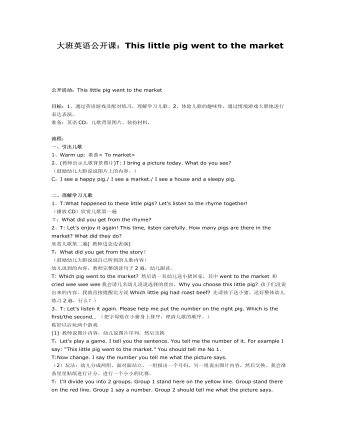
大班英语教案:This little pig went to the market
流程: 一、引出儿歌 1、Warm up: 歌曲< To market> 2、(教师出示儿歌背景图片)T: I bring a picturetoday. What do you see? (鼓励幼儿大胆说说图片上的内容。) C:I see a happy pig./ I see a market./ Isee a house and a sleepy pig. 二、理解学习儿歌 1、T:What happened to these little pigs?Let’s listen to the rhyme together! (播放CD)欣赏儿歌第一遍 T:What did you get from the rhyme?

大班英语教案:The very hungry caterpillar
3、愉快积极参与有关英语游戏,体验英语活动的乐趣。 活动准备:一个神秘箱、一个果篮 一条毛毛虫 各种毛毛虫食物的头饰及图片 根据故事情节制作的Flash课件 根据故事情节制作的图谱 活动过程:1、猜一猜 (1) 将部分毛毛虫的食物及毛毛虫放在神秘箱里,让幼儿摸其中一样, 然后猜一猜摸到的是什么,然后拿出来验证猜测结果。教师首先示范, 用动作提示幼儿操作。 Look, it’s a secret box .What’s in it ? I will feel one kind of, will feel what it is?幼儿摸到毛毛虫,教师说 the caterpillar can-------(用动作引导幼儿说creep)。 (2 ) T: a le is sweet, do you want to eat ? s: Yes。T:caterpillar is sweet ,do youwant to eat? T: a le pinea le banana orange peach and pear are all sweet,we like eating them,and the caterpillar also likes eating them . what did thecaterpillar eat ? let’s see.
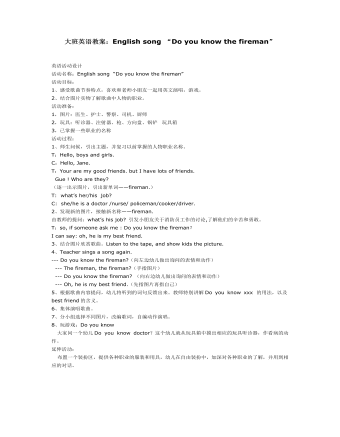
大班英语教案:English song “Do you know the fireman”
活动目标: 1、感受歌曲节奏特点,喜欢和老师小朋友一起用英文演唱,游戏。 2、结合图片实物了解歌曲中人物的职业。 活动准备: 1,图片:医生、护士、警察、司机、厨师 2,玩具:听诊器、注射器、枪、方向盘、锅铲 玩具箱 3,已掌握一些职业的名称 活动过程: 1、师生问候,引出主题,并复习以前掌握的人物职业名称。 T:Hello, boys and girls. C:Hello, Jane. T:Your are my good friends.but I have lots of friends. Gue ! Who are they? (逐一出示图片,引出新单词——fireman.) T: what’s her/his job? C: she/he is a doctor /nurse/policeman/cooker/driver.

《念奴娇 赤壁怀古》说课稿(一) 统编版高中语文必修上册
一、说教材:(一)教材的地位和作用《念奴娇﹒赤壁怀古》是部编版高中语文教材必修上册第9课的课文。它与辛弃疾的《永遇乐﹒京口北固亭怀古》,李清照的《声声慢》共同入选该册教材第三单元阅读古诗词,感悟人生这一学习专题。本词是苏轼的代表作,也是豪放词的名篇,在古诗词教学中占有重要的地位。优美的诗词是中华传统文化的瑰宝,学习这些诗词的目的在于培养学生鉴赏古代诗词作品的能力,在分析、鉴赏中感悟前人丰饶的情思,博大的智慧,从而提高学生的人文素养,提高文化品味。这首词写于元丰五年,是苏轼被贬黄州游赤鼻矶所作。本词感情激荡,意境雄浑壮阔。全词融写景、咏史、抒情为一体。通过学习,学生可以获得一些鉴赏诗词的基本要领,领略壮阔意境,感受豪放词风;同时学习苏轼在逆境中依然乐观旷达的人生观。
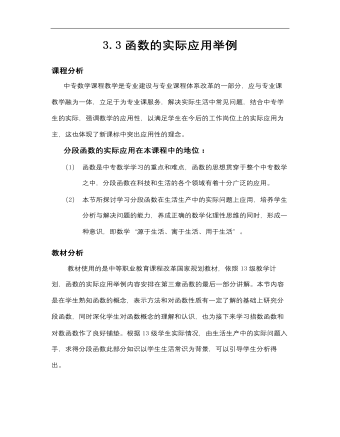
【高教版】中职数学基础模块上册:3.3《函数的实际应用举例》教学设计
课程分析中专数学课程教学是专业建设与专业课程体系改革的一部分,应与专业课教学融为一体,立足于为专业课服务,解决实际生活中常见问题,结合中专学生的实际,强调数学的应用性,以满足学生在今后的工作岗位上的实际应用为主,这也体现了新课标中突出应用性的理念。分段函数的实际应用在本课程中的地位:(1) 函数是中专数学学习的重点和难点,函数的思想贯穿于整个中专数学之中,分段函数在科技和生活的各个领域有着十分广泛的应用。(2) 本节所探讨学习分段函数在生活生产中的实际问题上应用,培养学生分析与解决问题的能力,养成正确的数学化理性思维的同时,形成一种意识,即数学“源于生活、寓于生活、用于生活”。教材分析 教材使用的是中等职业教育课程改革国家规划教材,依照13级教学计划,函数的实际应用举例内容安排在第三章函数的最后一部分讲解。本节内容是在学生熟知函数的概念,表示方法和对函数性质有一定了解的基础上研究分段函数,同时深化学生对函数概念的理解和认识,也为接下来学习指数函数和对数函数作了良好铺垫。根据13级学生实际情况,由生活生产中的实际问题入手,求得分段函数此部分知识以学生生活常识为背景,可以引导学生分析得出。
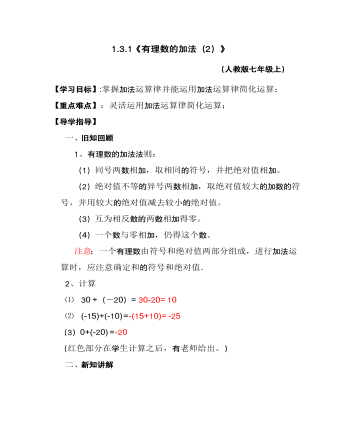
初中数学七年级上册第一章有理数加法第二课时
一、旧知回顾1、有理数的加法法则:(1)同号两数相加,取相同的符号,并把绝对值相加。(2)绝对值不等的异号两数相加,取绝对值较大的加数的符号,并用较大的绝对值减去较小的绝对值。(3)互为相反数的两数相加得零。(4)一个数与零相加,仍得这个数。注意:一个有理数由符号和绝对值两部分组成,进行加法运算时,应注意确定和的符号和绝对值.
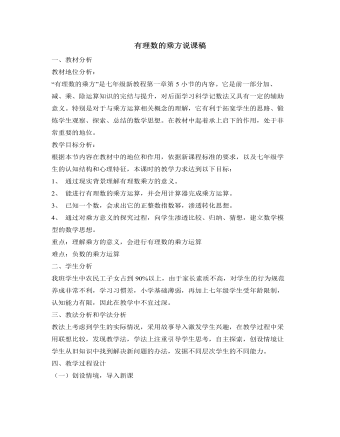
北师大初中数学七年级上册有理数的乘方说课稿
说明:此处进行的是一次尝试应用乘方运算来解决开头的问题,互相呼应,以体现整节课的完整性,把学生开始的兴趣再次引向高潮。趣味探索:一张薄薄的纸对折56次后有多厚?试验一下你能折这么厚吗?说明:这个探索实际上仍是对学生应用能力的一个检查,纸对折56次,用什么运算来计算比较方便,另外计算过程中可使用计算器,进一步加深对乘方意义的理解(五)作业P56页1、2说明:这两个习题是对课本上例题的简单重复和模仿,通过本节课的学习,多数学生应该可以较轻松地完成。总之,在整个教学设计中,我始终以学生为课堂主体,让他们积极参与到教学中来,不断从旧知识中获得新的认识,通过不断进行联系比较,让学生主动自觉地去思考、探索、总结直至发现结果、发现"方法",进而优化了整个教学。
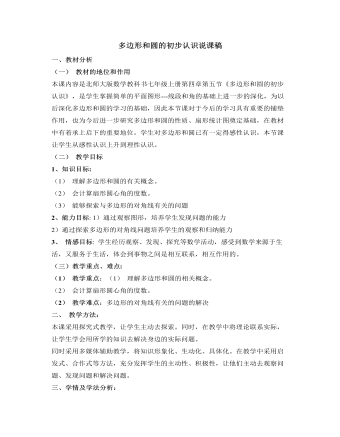
北师大初中数学七年级上册多边形和圆的初步认识说课稿
将一个圆分成三个大小相同的扇形,你能计算出它们的圆心角的度数吗?你知道每个扇形的面积和整个圆的面积的关系吗?与同伴交流设计意图:通过引导学生根据圆心角与圆心角的比例确定扇形面积与整圆的面积关系为后面学习扇形面积公式做铺垫,体现知识的延续性。(六)、巩固练习.如图,把一圆分成三个扇形,你能求出这三个扇形的圆心角吗?若圆的半径为2,你能求出各部分的面积吗?(七)、课堂小结学完这节课你有哪些收获?设计意图:通过小节让学生对所学知识进行梳理,使所学知识能合理地纳入自身的知识结构。(八) 布置作业:中等学生:P125. 1优等生: P125. 2,3我针对学生素质的差异设计了有层次的训练题,留给学生课后自主探究,这样即使学生掌握基础知识,又使学有余力的学生有所提高,从而达到拔尖和“减负”的目的。
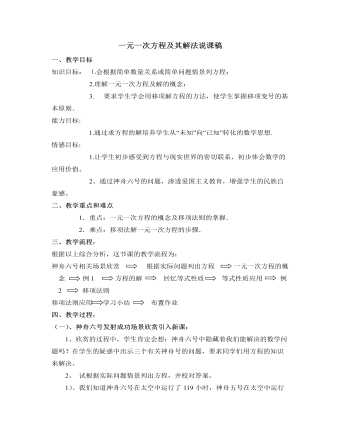
北师大初中数学七年级上册一元一次方程及其解法说课稿
还有其他解法吗?从中让学生体会解一元一次方程就是根据是等式的性质把方程变形成“x=a(a为已知数)”的形式(将未知数的系数化为1),这也是解方程的基本思路。并引导学生回顾检验的方法,鼓励他们养成检验的习惯)5、提出问题:我们观察上面方程的变形过程,从中观察变化的项的规律是什么?多媒体展示上面变形的过程,让学生观察在变形过程中,变化的项的变化规律,引出新知识.师提出问题:1.上述演示中,题目中的哪些项改变了在原方程中的位置?怎样变的?2.改变的项有什么变化?学生活动:分学习小组讨论,各组把讨论的结果上报教师,最好分四组,这样节省时间.师总结学生活动的结果:-2x改变符号后从等号的一边移到另一边。师归纳:像上面那样,把方程中的某项改变符号后,从方程的一边移到另一边的变形叫做移项.这里应注意移项要改变符号.

北师大初中数学七年级上册统计图的选择说课稿
四、教学过程分析为有序、有效地进行教学,本节课我主要安排了以下教学环节:(一)复习导入主要复习一下三种统计图,为接下来介绍三种统计图的特点及根据实际问题选取适当的统计图做好知识准备。(二)问题探究选取课本上“小华对1992~2002年同学家中有无电视机及近一年来同学在家看电视的情况”的3个调查项目,进而设计3个探究问题从而加深学生对每一种统计图的进一步认识,至此用自己的语言总结出每一种统计图的特点。(三)实践练兵这一环节通过2个实际问题的设计,通过学生对问题的分析、讨论,使学生认识到适当选取统计图有助于帮助人们去更快速、更准确地获取信息。(四)课堂小结总结这一节课所学的重点知识,这部分主要是让学生自己去总结,看看这节课自己有哪些收获。(五)作业布置进一步巩固本节课所学的知识,达到教学效果。以上就是我对这节课的见解,不足之处还望批评和指正。
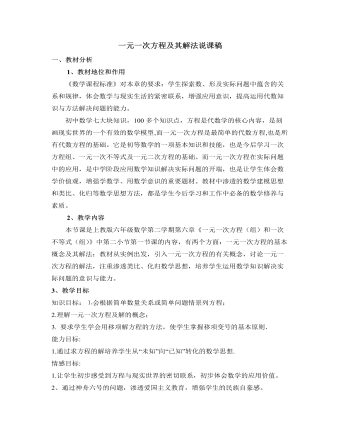
北师大初中数学七年级上册一元一次方程及其解法说课稿
1.上述演示中,题目中的哪些项改变了在原方程中的位置?怎样变的?2.改变的项有什么变化?学生活动:分学习小组讨论,各组把讨论的结果上报教师,最好分四组,这样节省时间.师总结学生活动的结果:-2x改变符号后从等号的一边移到另一边。师归纳:像上面那样,把方程中的某项改变符号后,从方程的一边移到另一边的变形叫做移项.这里应注意移项要改变符号.(三)理解性质,应用巩固师提出问题:我们可以回过头来,想一想刚解过的方程哪个变化过程可以叫做移项.学生活动:要求学生对课前解方程的变形能说出哪一过程是移项.对比练习: 解方程:(1) X+4=6 (2) 3X=2X+1(3) 3-X=0 (4) 9X=8X-3学生活动:把学生分四组练习此题,一组、二组同学(1)(2)题用等式性质解,(3)(4)题移项变形解;三、四组同学(1)(2)题用移项变形解,(3)(4)题用等式性质解.师提出问题:用哪种方法解方程更简便?解方程的步骤是什么?(答:移项法;移项、化简、检验.)
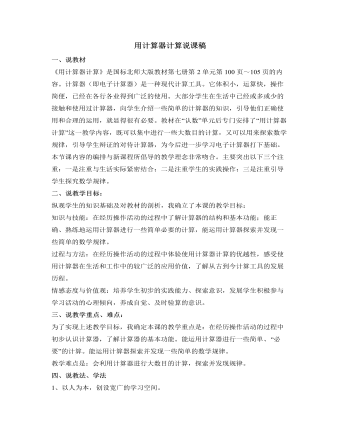
北师大初中数学七年级上册用计算器计算说课稿
一是先用计算器算出下面各题的积,再找一找有什么规律。目的是活跃气氛,激发学生探索数学规律的兴趣,为下面的数学探险作铺垫。二是数学探险。在这个步骤中,我先出示8个1乘8个1,学生用计算器计算的答案肯定不一样,因为学生带来的计算器所能显示的数位不一样,而且这些计算器所能显示的数位都不够用,也就是这道题目计算器不能解决。这时我提问:“你觉得问题出在哪儿?是我们错了,还是计算器错了?你能想办法解决吗?请四人小组讨论一下解决方案。”这样安排的目的是引发矛盾冲突,激发他们解决问题的需要和欲望。在学生找不到更好的解决方法时,引导学生向书本请教,完成课本第101页想想做做的第四题。让学生利用计算器算出前5题的得数,引导学生通过观察、比较、归纳、类比发现这些算式的规律,填写第6个算式,发展学生的合情推理能力,同时也让学生领略了数学的神奇。
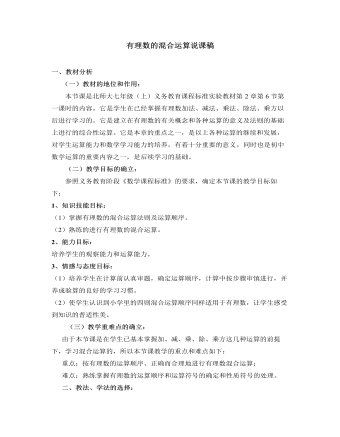
北师大初中数学七年级上册有理数的混合运算说课稿
一、教材分析(一)教材的地位和作用:本节课是北师大七年级(上)义务教育课程标准实验教材第2章第6节第一课时的内容。它是学生在已经掌握有理数加法、减法、乘法、除法、乘方以后进行学习的。它是建立在有理数的有关概念和各种运算的意义及法则的基础上进行的综合性运算。它是本章的重点之一,是以上各种运算的继续和发展,对学生运算能力和数学学习能力的培养,有着十分重要的意义,同时也是初中数学运算的重要内容之一,是后续学习的基础。(二)教学目标的确立:参照义务教育阶段《数学课程标准》的要求,确定本节课的教学目标如下:1、知识技能目标:(1)掌握有理数的混合运算法则及运算顺序。(2)熟练的进行有理数的混合运算。2、能力目标:培养学生的观察能力和运算能力。3、情感与态度目标:(1)培养学生在计算前认真审题,确定运算顺序,计算中按步骤审慎进行,并养成验算的良好的学习习惯。
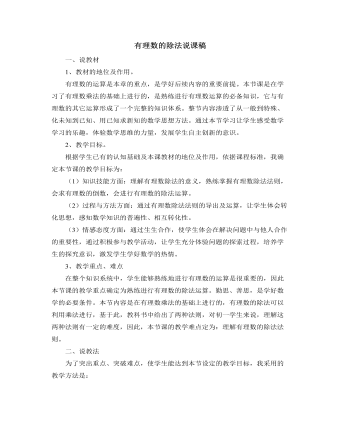
北师大初中数学七年级上册有理数的除法说课稿
五、两点说明。(一)、板书设计这节课的板书我是这样设计的,在黑板的正上方中间处写明课题,然后把板书分为左右两部分,左边是有理数除法的法则,为了培养学生把文字语言转化成符号语言的能力,板书中只出现两种法则的符号表示,从而加深他们对法则的理解,板书右边是学生的板演,以便于比较他们做题中出现的问题。板书下方是课堂小结,重点写出:有理数的除法可以转化成有理数的乘法,以体现本节课中的重要的数学思想方法。有理数的除法板演练习:有理数除法的法则:a÷b=a×1/b(b≠0) 1a>0,b>0,a/b>0;a0; 2a>0,b0,a/b<0. 3课堂小结:有理数的除法 有理数的乘法转化(二)、时间分配:教学过程中的八个环节所需的时间分别为:1分钟、2分钟、5分钟、8分钟、8分钟、16分钟、2分钟、1分钟。